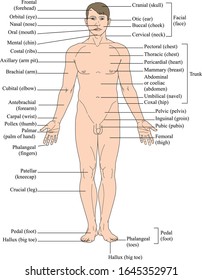Body Regions Labeled - Chapter 1 Lecture Powerpoint Ppt Download, The ventral cavity is on the front (anterior) of the body and is divided into the thoracic (chest) and abdominopelvic cavities.
Body Regions Labeled - Chapter 1 Lecture Powerpoint Ppt Download, The ventral cavity is on the front (anterior) of the body and is divided into the thoracic (chest) and abdominopelvic cavities.. Sep 02, 2019 · the entire human body is divided into regions, an approach called regional anatomy. They are named based off of the special function that the organs within that region perform or based on the blood or nerve supply to that region. Antebrachial (forearm) antecubital (inner elbow) brachial (upper arm) carpal (wrist) May 31, 2021 · body regions labeling. Check out our video on relative position:
See full list on healthpages.org Abdominal— relating to the abdomen. See full list on healthpages.org A plane is a theoretical line that divides the body. The lower limb region is a combination of all of the leg regions.

The most widely used regional terms used are those that describe the 9 abdominal regionsshown in the image to the right.
The theoretical plane that divides the body down the middle into equal left and right sides is known as the median sagittal plane. Body cavities are areas in the body that contain our vital organs. Body regions are further subdivisions of the body quadrants. These terms are often used to describe the arms and legs. Brachial — over the brachialartery i.e. For the most part, directional terms are grouped in pairs of opposites based on the standard anatomical position. Quadrants are another way our bodies are divided into regions for both diagnostic and descriptive purposes. Body areasis just another way to describe regions of the body. If you were describing the shin bone, the proximal end would be the end closest to the knee and the distal end would be the end closest to the foot. The right upper, right lower, left upper, and left lower quadrants. Some regions are combined into larger regions. Coronal (also known as frontal) plane — a vertical plane that divides the body into front and back halves 1. Over the skin crease there) 1.
If you were describing the shin bone, the proximal end would be the end closest to the knee and the distal end would be the end closest to the foot. Learn vocabulary, terms, and more with flashcards, games, and other study tools. For a topic like anatomical regions of the body, labeling exercises are a highly intuitive way to learn. The quadrants are labeled by location: Each main area (head, neck, thorax, abdomen, upper, and lower extremities) is divided into several smaller regions that aid compartmentalization.

See full list on healthpages.org
The cephalic region is a combination of all of the head regions. The most widely used regional terms used are those that describe the 9 abdominal regionsshown in the image to the right. Buccal— of or relating to the cheeks or the mouth 1. The elbow is superior (above) to the hand. Over the skin crease there) 1. You may also find scapular, interscapular, vertebral, lumbar, sacral, gluteal, dorsum of hand, perineal, popliteal, calcaneal, human body region as well. The ventral cavity is on the front (anterior) of the body and is divided into the thoracic (chest) and abdominopelvic cavities. More images for body regions labeled » If you were describing the shin bone, the proximal end would be the end closest to the knee and the distal end would be the end closest to the foot. Spend a few minutes connecting what you've learned in the video with what you see labeled. For the most part, directional terms are grouped in pairs of opposites based on the standard anatomical position. Oblique plane (not shown in the figure) is a slanted plane (at an angle) that lies between the horizontal and vertical plane. Body areasis just another way to describe regions of the body.
Body regions are further subdivisions of the body quadrants. Transverse (also known as axial orhorizontal) plane — this horizontal plane is parallel to the ground and divides the body into upper and lower halves. These include the trunk, which is a combination of the thoracic, mammary, abdominal, navel, and coxal regions. The theoretical plane that divides the body down the middle into equal left and right sides is known as the median sagittal plane. Scapular — of or relating to the area near the shoulder blade (scapula) 1.

Oftentimes, these terms are used within the context of advanced medical imaging studies such as computed tomography (ct) and magnetic resonance imaging (mri) scans.
If you were describing the shin bone, the proximal end would be the end closest to the knee and the distal end would be the end closest to the foot. Body cavities are areas in the body that contain our vital organs. For a topic like anatomical regions of the body, labeling exercises are a highly intuitive way to learn. More images for body regions labeled » A plane is a theoretical line that divides the body. Body regions are further subdivisions of the body quadrants. Sep 02, 2019 · the entire human body is divided into regions, an approach called regional anatomy. The theoretical plane that divides the body down the middle into equal left and right sides is known as the median sagittal plane. The elbow is superior (above) to the hand. Below are examples of some relevant terms: Antecubital— region of the arm in front of the elbow i.e. The ventral cavity is on the front (anterior) of the body and is divided into the thoracic (chest) and abdominopelvic cavities. Popliteal— region on the back of the knee (i.e.